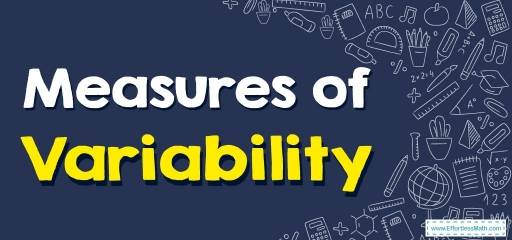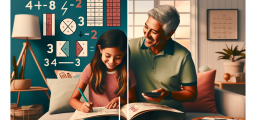How to Find Measures of Variability? (+FREE Worksheet!)

A variance is a number that indicates how a series of data is distributed around the mean value. The sample variance of a set of \(n\) sample data is the number \(s^2\) defined by the formula \(s^2={\frac{∑(x- \bar x)^2}{n-1}}\).
The square root \(s\) of the sample variance is called the sample standard deviation of a set of \(n\) sample data \(s=\sqrt{\frac{∑(x- \bar x)^2}{n-1}}\). The standard deviation \((σ)\) is one of the scattering indices that shows how far the data is from the average value. If the standard deviation of a set of data is close to zero, it indicates that the data are close to the mean and have little scatter; While a large standard deviation indicates significant data scatter.
Find Measures of Variability Example 1:
Find the range and sample variance of the data set table:
| Data | 43 | 8 | 32 | 16 | 25 | 47 | 19 | 22 | 31 |
Solution: for the data set the maximum is \(47\) and the minimum is \(8\), so the range is \(R=47-8=39\). For sample variance use defining formula \(s^2={\frac{∑(x- \bar x)^2}{n-1}}\). We first compute for each observation \(x\) its deviation \(x- \bar x\) from the sample mean. Since the mean of the data is \(27\), we obtain the numbers displayed in the second line of the supplied table
| \(x\) | 43 | 8 | 32 | 16 | 25 | 47 | 19 | 22 | 31 |
| \(x- \bar x\) | 19 | -19 | 5 | -11 | -2 | 20 | -8 | -5 | 4 |
Thus \(∑(x- \bar x)^2=(19)^2+(-19)^2+(5)^2+(-11)^2+(-2)^2+(20)^2+(-8)^2+(-5)^2+(4)^2=1,377\)
So the variance is \(s^2={\frac{∑(x- \bar x)^2}{n-1}}=\frac{1377}{8}=172.125\)
Find Measures of Variability Example 2:
Find the range and sample variance of the data set table:
| Data | 26 | 19 | 18 | 29 | 32 | 24 | 30 | 25 |
Solution: for the data set the maximum is \(32\) and the minimum is \(18\), so the range is \(R=32-18=14\). For sample variance use defining formula \(s^2={\frac{∑(x- \bar x)^2}{n-1}}\). We first compute for each observation \(x\) its deviation \(x- \bar x\) from the sample mean. Since the mean of the data is \(25.4\), we obtain the numbers displayed in the second line of the supplied table
| \(x\) | 26 | 19 | 18 | 29 | 32 | 24 | 30 | 25 |
| \(x- \bar x\) | 0.6 | -6.4 | -7.4 | 3.6 | 6.6 | -1.4 | 4.6 | -0.4 |
Thus \(∑(x- \bar x)^2=(0.6)^2+(-6.4)^2+(-7.4)^2+(3.6)^2+(6.6)^2+(-1.4)^2+(4.6)^2+(-0.4)^2=175.88\)
So the variance is \(s^2={\frac{∑(x- \bar x)^2}{n-1}}=\frac{175.88}{7}=25.13\)
Exercises for Finding Measures of Variability
Find the sample variance and standard deviation of each data set table.
1)
| Data | 32 | 45 | 50 | 42 | 37 | 46 | 40 |
2)
| Data | 14 | 9 | 22 | 31 | 11 | 19 | 29 | 25 |
1) Sample variance: 36.24
standard deviation: 6.02
2) Sample variance: 67.14
standard deviation: 8.19
Related to This Article
More math articles
- How to do well on the PSAT test?
- How to Create a Praxis Core Math Study Plan?
- 3rd Grade MCAS Math Practice Test Questions
- TExES Core Subjects Math Formulas
- CHSPE Math-Test Day Tips
- How to Classify Polygons: A Step-by-Step Guide to Shape Identification
- TABE Math Practice Test Questions
- How to Apply Integers Addition and Subtraction Rules?
- How to Help Your 3rd Grade Student Prepare for the Texas STAAR Math Test
- Top 10 7th Grade NYSE Math Practice Questions






































What people say about "How to Find Measures of Variability? (+FREE Worksheet!) - Effortless Math: We Help Students Learn to LOVE Mathematics"?
No one replied yet.